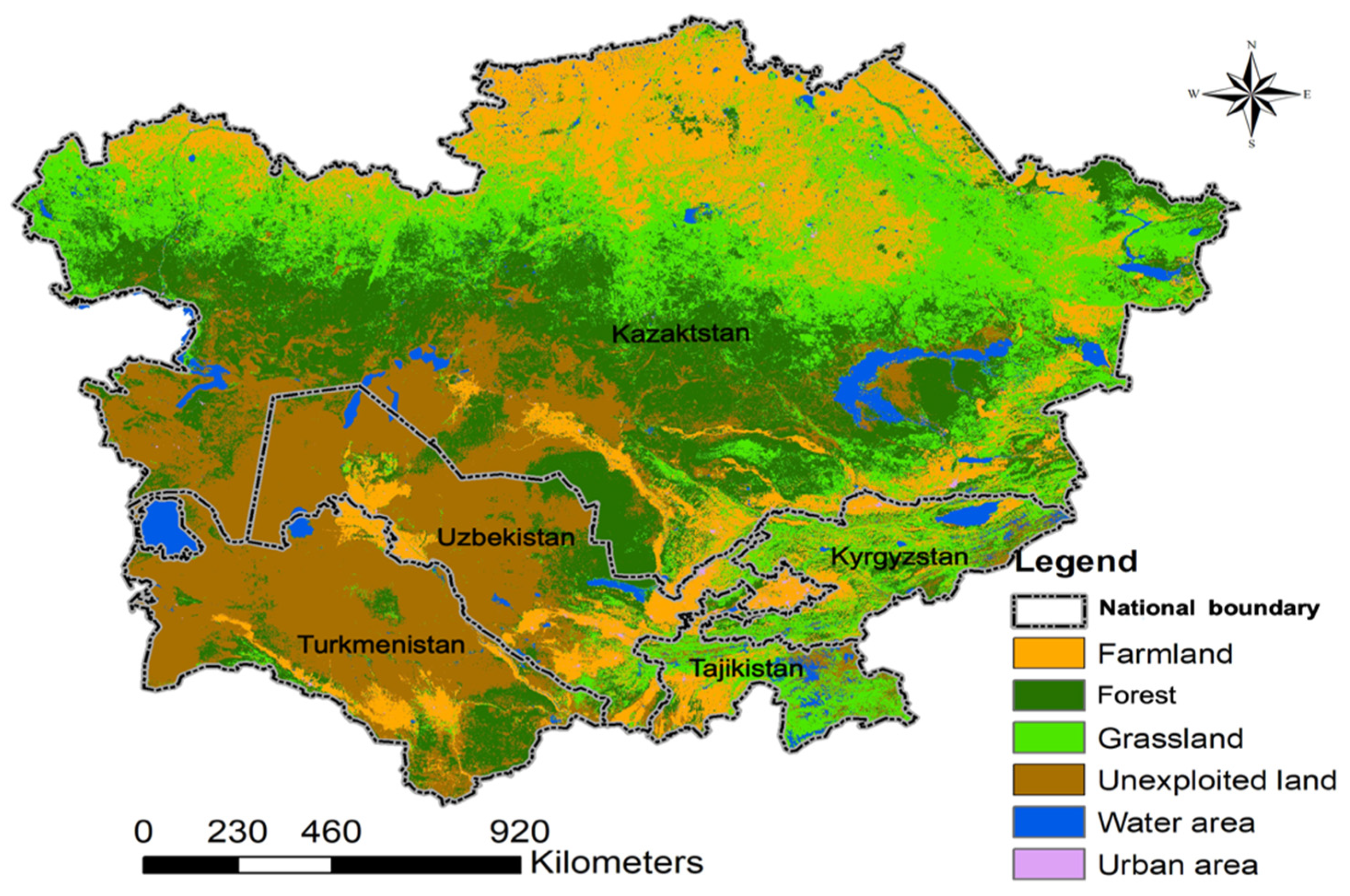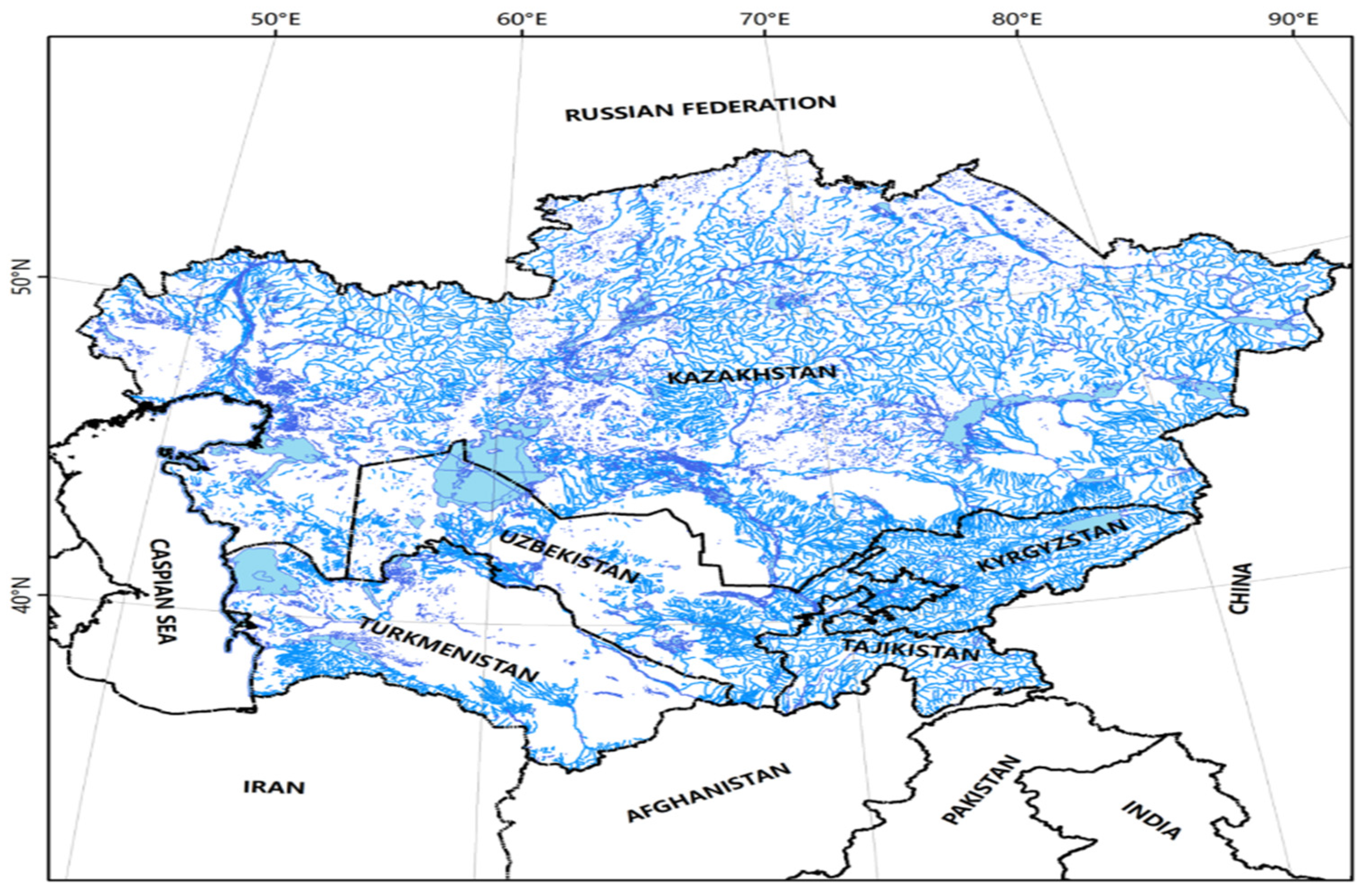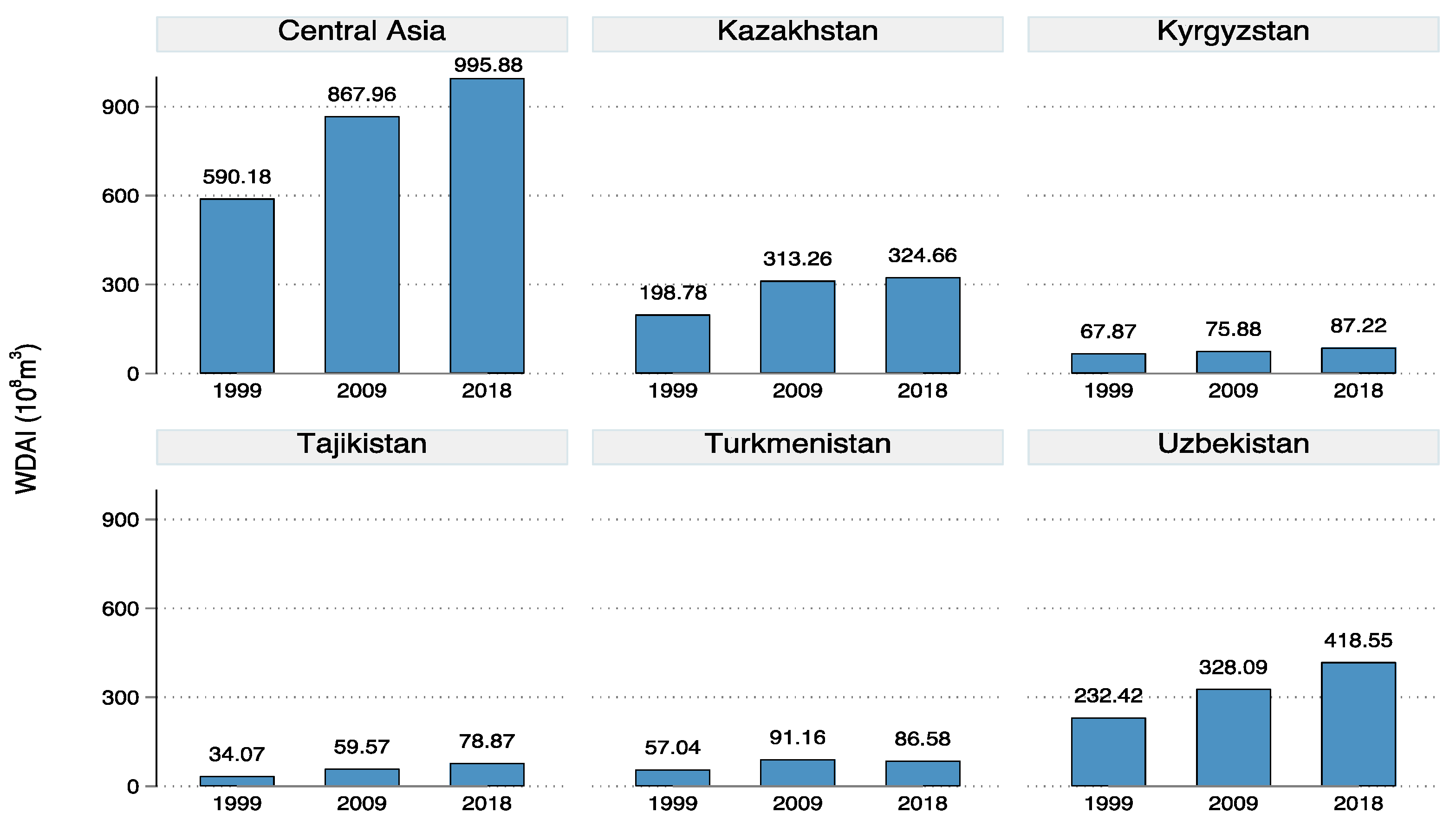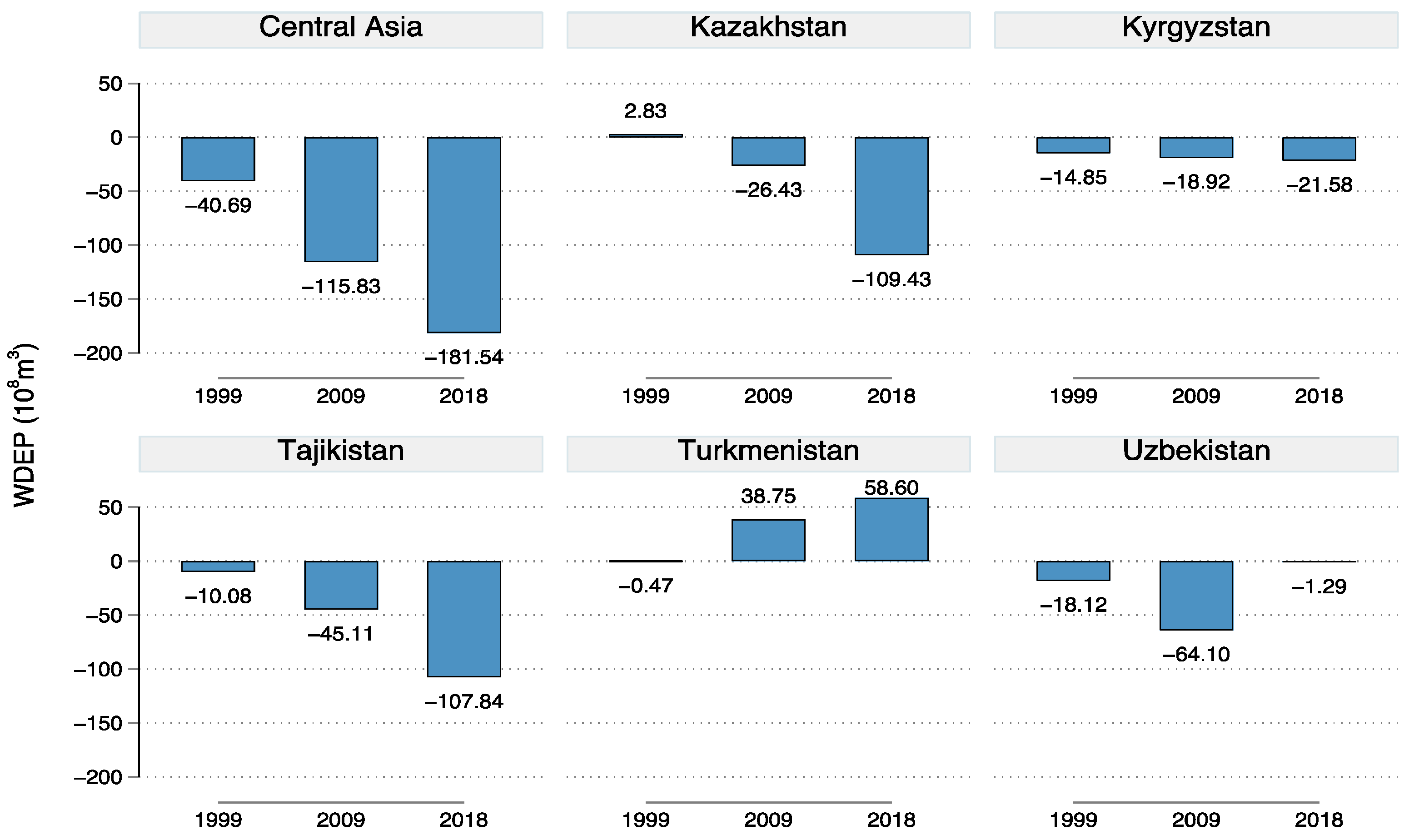Assessment on Land-Water Resources Carrying Capacity of Countries in Central Asia from the Perspective of Self-Supplied Agricultural Products
Abstract
:1. Introduction
2. Data and Methodology
2.1. Agricultural Products Consumption in Central Asia
2.2. Demand of Land-Water Resources for Food Consumption in Central Asia
2.2.1. Agricultural Farmland Demand
2.2.2. WDAI and WDEP
2.3. Supply–Demand Balance of Land-Water Resources in Central Asia
2.4. The Population Carrying Capacity Based on Matching Land-Water Resources in Central Asia
2.5. Data Source
3. Results
3.1. Supply–Demand Balance Status of Farmland in Central Asia
3.2. Supply–Demand Balance Status of Agricultural Water Resources in Central Asia
3.2.1. Spatial Differences in Supply–Demand of WDAI in Central Asia
3.2.2. Spatial Differences in Supply–Demand of WDIEP in Central Asia
3.3. Population Carrying Capacity of Farmland and Agricultural Water Sources in Central Asia
4. Discussion
4.1. Carrying Capacity Changes of Agricultural Land-Water Resources in Central Asia and Analyses of Main Causes
4.2. Simulating the Carrying Capacity of Land-Water Resources in Central Asia under the Assumption of World Average Yield and Agricultural Input Levels
5. Conclusions
Author Contributions
Funding
Institutional Review Board Statement
Informed Consent Statement
Data Availability Statement
Acknowledgments
Conflicts of Interest
References
- Food and Agriculture Organization of the United Nations; International Fund for Agricultural Development; United Nations International Children’s Emergency Fund; World Food Programme; World Health Organization. The State of Food Security and Nutrition in the World 2021. Transforming Food Systems for Food Security, Improved Nutrition and Affordable Healthy Diets for All; FAO: Rome, Italy, 2021. [Google Scholar] [CrossRef]
- United Nations. Trends in Sustainable Development: Agriculture, Rural Development, Land, Desertification, and Drought; United Nations: New York, NY, USA, 2008.
- Independent Group of Scientists Appointed by the Secretary-General. Global Sustainable Development Report 2019: The Future Is Now—Science for Achieving Sustainable Development; United Nations: New York, NY, USA, 2019.
- Scherr, S.J.; Yadav, S. Land Degradation in the Developing World—Issues and Policy Options for 2020. In The Unfinished Agenda: Perspectives on Overcoming Hunger, Poverty, and Environmental Degradation; Pinstrup-Andersen, P., Pandya-Lorch, R., Eds.; IFPRI: Washington, DC, USA, 2001; Chapter 21; p. 302. [Google Scholar]
- Ostrom, E. A general framework for analyzing sustainability of social-ecological systems. Science 2009, 325, 419–422. [Google Scholar] [CrossRef] [PubMed]
- Wang, S.F.; Xu, Y.; Liu, T.J.; Ye, J.M.; Pan, B.L.; Chu, C.; Peng, Z.L. Review of evaluation on ecological carrying capacity: The progress and trend of methodology. IOP Conf. Ser. Earth Environ. Sci. 2018, 113, 012108. [Google Scholar] [CrossRef]
- Qian, G.; Chuanglin, F.; Xuegang, C. Carrying capacity for SDGs: A review of connotation evolution and practice. Environ. Impact Assess. Rev. 2021, 91, 106676. [Google Scholar] [CrossRef]
- Ma, P.; Ye, G.; Peng, X.; Liu, J.; Qi, J.; Jia, S. Development of an index system for evaluation of ecological carrying capacity of marine ecosystems. Ocean. Coast. Manag. 2017, 144, 23–30. [Google Scholar] [CrossRef]
- Wang, Q.; Yuan, X.; Zhang, J.; Mu, R.; Yang, H.; Ma, C. Key evaluation framework for the impacts of urbanization on air environment—A case study. Ecol. Indic. 2013, 24, 266–272. [Google Scholar] [CrossRef]
- Zhou, K.; Fan, J. Characteristics and influence factors of resources and environment carrying capacity in underdeveloped areas of China. Geogr. Res. 2015, 34, 39–52. (In Chinese) [Google Scholar]
- Chen, X. Overview of Central Asia Environments; China Meteorological Press: Beijing, China, 2015. (In Chinese) [Google Scholar]
- Kawabata, M.; Berardo, A.; Mattei, P. Food security and nutrition challenges in Tajikistan: Opportunities for a systems approach. Food Policy 2020, 96, 101872. [Google Scholar] [CrossRef]
- Chen, F.; Yuan, Y.J. Streamflow reconstruction for the Guxiang River, eastern Tien Shan (China): Linkages to the surrounding rivers of Central Asia. Environ. Earth Sci. 2016, 75, 1049. [Google Scholar] [CrossRef]
- Deng, H.; Chen, Y. Influences of recent climate change and human activities on water storage variations in Central Asia. J. Hydrol. 2017, 544, 46–57. [Google Scholar] [CrossRef]
- Groll, M.; Kulmatov, R.; Mullabaev, N. Rise and decline of the fishery industry in the Aydarkul–Arnasay Lake System (Uzbekistan): Effects of reservoir management, irrigation farming and climate change on an unstable ecosystem. Environ. Earth Sci. 2016, 75, 921. [Google Scholar] [CrossRef]
- Abdullaev, I.; Rakhmatullaev, S. River basin management in Central Asia: Evidence from Isfara Basin, Fergana Valley. Environ. Earth Sci. 2016, 75, 677. [Google Scholar] [CrossRef]
- Sakal, H.B. Hydroelectricity aspect of the Uzbek-Kyrgyz water dispute in the Syr Darya Basin. Enerj. Diplomasi Derg. 2015, 1, 94–133. [Google Scholar]
- Sun, J.; Li, Y.P.; Suo, C. Impacts of irrigation efficiency on agricultural water-land nexus system management under multiple uncertainties—A case study in Amu Darya River basin, Central Asia. Agric. Water Manag. 2019, 216, 76–88. [Google Scholar] [CrossRef]
- Hamidov, A.; Helming, K.; Balla, D. Impact of agricultural land use in Central Asia: A review. Agron. Sustain. Dev. 2016, 36, 6. [Google Scholar] [CrossRef] [Green Version]
- Pender, J.; Mirzabaev, A.; Kato, E. Economic Analysis of Sustainable Land Management Options in Central Asia. Final Report for the ADB; IFPRI: Washington, DC, USA; ICARDA: Beirut, Lebanon, 2009; p. 168. [Google Scholar]
- Kienzler, K.M.; Lamers, J.P.A.; McDonald, A. Conservation agriculture in Central Asia—What do we know and where do we go from here. Field Crop. Res. 2012, 132, 95–105. [Google Scholar] [CrossRef]
- Petrick, M.; Gramzow, A.; Oshakbaev, D.; Wandel, J. A Policy Agenda for Agricultural Development in Kazakhstan (Issue 15); Leibniz Institute of Agricultural Development in Transition Economies (IAMO): Halle (Saale), Germany, 2014. [Google Scholar]
- Gong, B.L. China’s Agricultural Cooperation with the Belt and Road Countries. Chin. Rural. Econ. 2019, 10, 114–129. (In Chinese) [Google Scholar]
- Xin, P.; Han, S.; Yang, Y.; Zhou, X.; Zhou, H. Changes in water requirements for production and virtual water trade of cotton in Central Asia. Chin. J. Eco-Agric. 2021, 29, 290–298. (In Chinese) [Google Scholar]
- Tang, H.J.; Li, Z.M. Study on per capita grain demand based on Chinese reasonable dietary pattern. Sci. Agric. Sin. 2012, 45, 2315–2327. (In Chinese) [Google Scholar]
- Xiao, Y.; Cheng, S.K.; Xie, G.D. The balance between supply and consumption of the main types of grain in China. J. Nat. Resour. 2017, 32, 927–936. (In Chinese) [Google Scholar]
- Huang, C.Y.; Zhang, W.B.; Jiang, S.F. Comparison of important characters and productive status between sugar-beet and sugarcane in China. Sugar Crop China. 2006, 2, 41–44, 54. (In Chinese) [Google Scholar]
- Zhang, Y.X.; Li, X.D. Analyses of Food supply-demand balance status at provincial level and policy implication in China from the perspective of Resources and environment. J. Nat. Resour. 2021, 36, 1573–1587. (In Chinese) [Google Scholar]
- Xie, H.Y.; Chen, X.S.; Yang, M.Z. The ecological footprint analysis of 1kg livestock product of China. Acta Ecol. Sin. 2009, 29, 3264–3270. (In Chinese) [Google Scholar]
- Ma, C.; Yang, Z.; Song, J.; Hao, C.; Xia, R.; Jia, R.; Chen, Y.; Zhang, X. Characteristics of crop water footprint changes in five Central Asian countries from 1992 to 2017. Chin. J. Eco-Agric. 2021, 29, 269–279. (In Chinese) [Google Scholar]
- Ge, J.H.; Zhou, S.D. Analysis of economic influence factors of agricultural non-point source pollution: Based on data of Jiangsu Province from 1978 to 2009. Chin. Rural. Econ. 2011, 5, 72–81. (In Chinese) [Google Scholar]
- Rao, J.; Xu, X.Y.; Ji, X.T. Research on the current situation, occurrence mechanism and countermeasures of agricultural non-point source pollution in China. Issues Agric. Econ. 2011, 8, 81–87. [Google Scholar]
- Zhang, H.; Hu, H. Verification of Environmental Kuznets Curve for agricultural non-point source pollution: An analysis based on temporal data of Jiangsu Province. Chin. Rural. Econ. 2009, 4, 48–53, 71. [Google Scholar]
- Deng, Y.; Gou, X.; Gao, L. Tree-ring recorded moisture variations over the past millennium in the Hexi Corridor, northwest China. Environ. Earth Sci. 2017, 76, 272. [Google Scholar] [CrossRef]
- Oenema, O.; Van, L.L.; Plette, S. Environmental effects of manure policy options in the Netherlands. Water Sci. Technol. 2004, 49, 101–108. [Google Scholar] [CrossRef]
- Li, B.G.; Huang, F. Defining the baselines for China agricultural water use in green and blue water approach. Sci. Agric. Sin. 2015, 48, 3493–3503. [Google Scholar]
- Zhao, M.J. Agricultural Development in Central Asian: Resources, Zoning and Cooperation; China Agricultural Press: Beijing, China, 2018. (In Chinese) [Google Scholar]
- Shi, X.C.; Qian, Y.; Xiong, J.X. Application of fuzzy mathematical models in the evaluation of soil heavy metal pollution. Chin. J. Soil Sci. 2006, 37, 334–336. [Google Scholar]
- Karimov, B.K.; Matthies, M.; Talskikh, V.; Plotsen, M.A.; Karimov, E.B. Salinization of river waters and suitability of electric conductivity value for saving freshwater from salts in Aral Sea Basin. Asian J. Water Environ. Pollut. 2019, 16, 109–114. [Google Scholar] [CrossRef]
- Yan, Z.; Tan, M. Changes in agricultural virtual water in Central Asia, 1992–2016. J. Geogr. Sci. 2020, 30, 1909–1920. [Google Scholar] [CrossRef]
- Russell, M. Water in Central Asia: An increasingly scarce resource. Eur. Parliam. Res. Serv. 2018. Available online: https://www.europarl.europa.eu/thinktank/en/document/EPRS_BRI(2018)625181 (accessed on 25 December 2021).
- Min, L.; Csa, B.; Fma, B. Assessing extreme climatic changes on a monthly scale and their implications for vegetation in Central Asia. J. Clean. Prod. 2020, 271, 122396. [Google Scholar] [CrossRef]
- Mo, X.; Hu, S.; Lin, Z.; Liu, S.; Xia, J. Impacts of climate change on agricultural water resources and adaptation on the north china plain. Adv. Clim. Chang. Res. 2017, 8, 93–98. (In Chinese) [Google Scholar] [CrossRef]
- Nam, W.; Choi, J.; Yoo, S.; Jang, M. A decision support system for agricultural drought management using risk assessment. Paddy Water Environ. 2012, 10, 197–207. [Google Scholar] [CrossRef]
- Zhang, J.; Chen, Y.; Li, Z. Assessment of efficiency and potentiality of agricultural resources in Central Asia. Geogr. Sci. 2018, 28, 1329–1340. [Google Scholar] [CrossRef] [Green Version]
- Komissarov, A.; Komissarov, M.; Safin, K.; Ishbulatov, M.; Kovshov, Y. Long-term irrigation effect on soil and vegetation cover of floodplain estuaries in the Southern Urals. Asian J. Water Environ. Pollut. 2020, 17, 83–90. [Google Scholar] [CrossRef]
- Devkota, K.; Hoogenboom, G.; Boote, K. Simulating the impact of water saving irrigation and conservation agriculture practices for rice-wheat systems in the irrigated semi-arid drylands of Central Asia. Agric. For. Meteorol. 2015, 214–215, 266–280. [Google Scholar] [CrossRef]
- Nasiev, B.N.; Eleshev, R. Modern state of the soils of flood irrigation systems in the semidesert zone. Eurasian Soil Sci. 2014, 47, 613–620. [Google Scholar] [CrossRef]
- Frenken, K. Irrigation in Central Asia in Figures: AQUASTAT Survey-2012; FAO Water Reports; FAO: Rome, Italy, 2013; Volume 39. [Google Scholar]
- Ospanbayev, Z.H.O.; Kurmanbayeva, M.S.; Abdukadirova, Z.H.A.; Doszhanova, A.S.; Nazarbekova, S.T.; Inelova, Z.A.; Ablaikhanova, N.T.; Kenenbayev, S.B.; Musina, A.S. Water use efficiency of rice and soybean under drip irrigation with mulch in the south-east of Kazakhstan. Appl. Ecol. Environ. Res. 2017, 15, 1581–1603. [Google Scholar] [CrossRef]
- Balmford, A. Crop expansion and conservation priorities in tropical countries. PLoS ONE 2013, 8, e51759. [Google Scholar]
- Latawiec, A.E.; Strassburg, B.N.S.; Rodriguez, A.M.; Matt, E.; Nijbroek, R.; Silos, M. Suriname: Reconciling agricultural development and conservation of unique natural wealth. Land Use Policy 2014, 38, 627–636. [Google Scholar] [CrossRef] [Green Version]
- Ahmed, S.M. Impacts of drought, food security policy and climate change on performance of irrigation schemes in Sub-saharan Africa: The case of Sudan. Agric. Water Manag. 2020, 232, 106064. [Google Scholar] [CrossRef]
- Foresight. The Future of Food and Farming 2011. Final Project Report; The Government Office for Science: London, UK, 2011.
- Godfray, H.C.J.; Beddington, J.R.; Crute, I.R.; Haddad, L.; Lawrence, D.; Muir, J.F.; Pretty, J.; Robinson, S.; Thomas, S.M.; Toulmin, C. Food security: The challenge of feeding 9 billion people. Science 2010, 327, 812–818. [Google Scholar] [CrossRef] [Green Version]
- Aznar-Sánchez, J.; Belmonte-Ureña, L.; Velasco-Muñoz, J.; Valera, D. Aquifer sustainability and the use of desalinated seawater for greenhouse irrigation in the campo de níjar, southeast Spain. Int. J. Environ. Res. Public Health 2019, 16, 898. [Google Scholar] [CrossRef] [Green Version]








| Scenario A | Scenario B | |||||
|---|---|---|---|---|---|---|
| 1999 | 2009 | 2018 | 1999 | 2009 | 2018 | |
| Central Asia | 33.03 | 7.53 | 1.22 | 32.94 | 6.62 | −0.48 |
| Of which: | ||||||
| Kazakhstan | 37.44 | 17.57 | 18.41 | 37.35 | 17.57 | 18.41 |
| Kyrgyzstan | 0.23 | −0.76 | −0.57 | 0.23 | −0.76 | −0.57 |
| Tajikistan | −2.51 | −2.94 | −4.45 | −2.51 | −2.94 | −4.44 |
| Turkmenistan | −0.86 | −1.43 | −1.63 | −0.86 | −2.35 | −3.34 |
| Uzbekistan | −1.27 | −4.90 | −10.54 | −1.27 | −4.90 | −10.54 |
| Country/Region | Population | Farmland | Agriculture Water | ||||||
|---|---|---|---|---|---|---|---|---|---|
| 1999 | 2009 | 2018 | 1999 | 2009 | 2018 | 1999 | 2009 | 2018 | |
| Center Asia | 54.05 | 60.02 | 70.87 | 41.24 | 37.59 | 38.56 | 1814.74 | 1695.5 | 1685.77 |
| Of which: | |||||||||
| Kazakhstan | 15.41 | 15.7 | 18.08 | 32.2 | 28.74 | 29.88 | 581.14 | 478.01 | 466.26 |
| Kyrgyzstan | 4.71 | 5.18 | 6.19 | 1.44 | 1.35 | 1.37 | 436.87 | 432.19 | 431.01 |
| Tajikistan | 5.94 | 7.06 | 8.88 | 0.89 | 0.88 | 0.85 | 632.78 | 624.87 | 624.87 |
| Turkmenistan | 4.36 | 4.87 | 5.76 | 1.89 | 2.05 | 2 | 13.61 | 13.20 | 13.20 |
| Uzbekistan | 23.64 | 27.2 | 31.96 | 4.83 | 4.57 | 4.46 | 150.34 | 147.23 | 150.44 |
| Farmland | WDAI | WDIEP | |
|---|---|---|---|
| Central Asia | 21.28 | 1256.54 | 1228.03 |
| Of which: | |||
| Kazakhstan | 24.3 | 326.33 | 326.33 |
| Kyrgyzstan | −0.021 | 393.41 | 393.41 |
| Tajikistan | −0.74 | 590.87 | 590.87 |
| Turkmenistan | 0.34 | −24.11 | −52.62 |
| Uzbekistan | −2.6 | −29.96 | −29.96 |
| Scenario A | Scenario B | |
|---|---|---|
| Central Asia | 0.51 | −1.42 |
| Of which: | ||
| Kazakhstan | 18.41 | 18.41 |
| Kyrgyzstan | −0.09 | −0.09 |
| Tajikistan | −4.23 | −4.23 |
| Turkmenistan | −1.63 | −3.56 |
| Uzbekistan | −11.95 | −11.95 |
Publisher’s Note: MDPI stays neutral with regard to jurisdictional claims in published maps and institutional affiliations. |
© 2022 by the authors. Licensee MDPI, Basel, Switzerland. This article is an open access article distributed under the terms and conditions of the Creative Commons Attribution (CC BY) license (https://creativecommons.org/licenses/by/4.0/).
Share and Cite
Zhao, Y.; Zhang, Y.; Li, X.; Qian, C. Assessment on Land-Water Resources Carrying Capacity of Countries in Central Asia from the Perspective of Self-Supplied Agricultural Products. Land 2022, 11, 278. https://doi.org/10.3390/land11020278
Zhao Y, Zhang Y, Li X, Qian C. Assessment on Land-Water Resources Carrying Capacity of Countries in Central Asia from the Perspective of Self-Supplied Agricultural Products. Land. 2022; 11(2):278. https://doi.org/10.3390/land11020278
Chicago/Turabian StyleZhao, Yuhan, Yongxun Zhang, Xiande Li, and Chen Qian. 2022. "Assessment on Land-Water Resources Carrying Capacity of Countries in Central Asia from the Perspective of Self-Supplied Agricultural Products" Land 11, no. 2: 278. https://doi.org/10.3390/land11020278
APA StyleZhao, Y., Zhang, Y., Li, X., & Qian, C. (2022). Assessment on Land-Water Resources Carrying Capacity of Countries in Central Asia from the Perspective of Self-Supplied Agricultural Products. Land, 11(2), 278. https://doi.org/10.3390/land11020278






